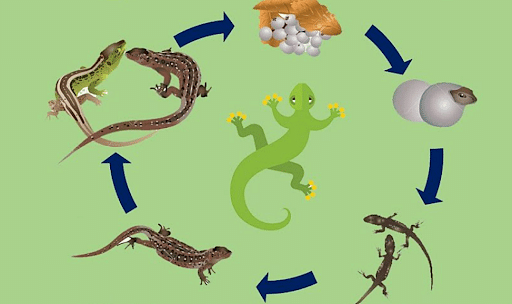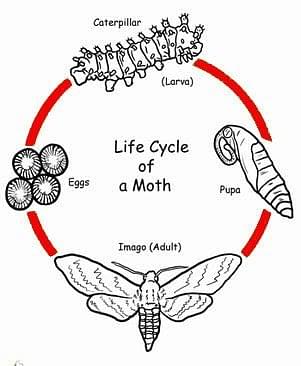
Collegedunia Team Content Curator
Content Curator
Lizards are reptiles and moths are members of the Lepidoptera order. While the majority of lizards run with a strong side-to-side motion, known as quadrupedal motion, moths have dark coloured wings with orange, red, and white stripes. Some of the lizards lack legs and have snake-like bodies, and the majority of them can glide. Moths have thick furry bodies linked to these wings. Lizards are mostly carnivorous because they need to eat predators to survive, especially terrestrial invertebrates while moths, in comparison, are gentle.
| Table of Content |
Key Takeaway - Lepidoptera, Reptiles, Carnivores, Predators, Invertebrates
Classification of Lizards and Moths
| Classification | Lizards | Moths |
|---|---|---|
| Kingdom | Animalia | Animalia |
| Phylum | Chordata | Arthropod |
| Class | Reptile | Insects |
| Order | Squamata | Lepidoptera |
Read More- Life Cycle of Silkworm
Life Cycle of Lizard
The lizard's life cycle is separated into three stages, which are described below:
Lying and Hatching of Eggs
The lizard's life cycle begins when it hatches from an egg, as certain species give birth to young, but lizards must go through a metamorphosis phase to continue their growth. Adult lizards lay eggs when they have matured, and the process of laying eggs and maturing into new adults repeats itself. Some lizard species lay their eggs in the hole and then abandon them. Some species will return to reheat the eggs, and incubation times range from 30 to 90 days.
The Juvenile Stage
Juvenile lizards are now ready to develop into fully mature individuals after hatching or giving birth. Juvenile lizards of some kinds do not receive adequate care from their parents.
The Adult Stage
When a lizard reaches adulthood, it has reached sexual maturity and is ready to mate. The season influences lizard mating; for example, the frilled lizard begins mating during the rainy season. By extending their frills, male lizards attract female lizards. Depending on the species, a female lizard can lay anywhere from 8 to 23 eggs after fertilization.

Lizards Life Cycle
Adaptation Done by Lizard for Survival
Lizards can thrive in every environment, even deep oceans and extreme temperatures. They are frequently confused with snakes due to their resemblance, however, one key difference between snakes and lizards is that lizards have legs and moveable eyelids. Lizards produce dry scaly skin, although most lizards lack it, allowing them to adapt to diverse environments. Lizards have incredible defense abilities. They have caudal autotomy, in which they use their tail to protect themselves and create a hostile environment for themselves. The most astounding trait of lizards is their ability to regrow their tails.
Read More:
Life Cycle of a Moth
The life cycle of moths in adult form and is commonly used in research is shown below. This caterpillar is a generalist, which means it eats practically anything, making it simple to nurture.
The Egg Stage
After mating, the female lays her eggs near a plant-filled region. Over 30 days, the embryo develops inside the eggs. In two weeks, a female moth can lay up to 50 eggs. Depending on the species, the female moth lays a different number of eggs. The larva develops inside the egg in 30 days and requires 7 to 10 days to grow. The growth of the larvae into a caterpillar embryo is accelerated by favorable environmental factors such as warm temperatures and humidity.
The Larvae (Caterpillar) Stage
For protein, the freshly hatched caterpillar or larva feeds on the shell that has been removed. Later, while the female moth lays her eggs nearby, the caterpillar feeds on all adjacent plants. The first instar of a larva is when it hatches. The caterpillar rises in size with each successive instar. The caterpillar, like other insects, goes through numerous stages of molting and skin shedding. The caterpillar eats the cuticle that is left over after molting and continues to feed and molt until it reaches the pupa stage.
The Pupa Stage
The caterpillar can weave silk that it makes from its proteins. The caterpillar next spins this silk around the shell, creating a cocoon. The moth develops from a pupa to a fully formed moth with wings inside its cocoon. The chrysalis stage is analogous to the pupa stage in butterflies. During the pupa stage, tissue breakdown is known as histolysis. The moth isn't moving since it isn't eating. The caterpillar changes into a moth with wings and emerges from the cocoon after about two weeks.
The Adult Stage
With a bloated abdomen and shriveled wings, the fully-fledged moth, also known as the imago, emerges from the cocoon. This occurs because moths' frail wings allow them to take longer to emerge from their cocoons. The newly born moth goes out to feed and mate after the delicate wings of the newly born moth grow more robust and hard. The life expectancy of a moth varies according to the species. Some species live for weeks, some for months, and even others for as long as ten weeks.

Moth Life Cycle
Things To Remember
- An adult moth does not live for more than a year in the majority of cases due to unfavorable weather conditions, presence of predators, etc.
- The average adult moth is around 3 cm long, although several species are much larger.
- The skin of most lizards is dry and scaly, and it does not increase as the lizard matures, instead, it loses its skin and regrows a new covering.
- When confronted with a dangerous environment, lizards have a remarkable defense mechanism called caudal autotomy, in which they self-amputate a portion of their tail.
Read More:
Sample Questions
Ques. How long can a lizard survive without eating? (2 marks)
Ans. The length of time a lizard may go without eating is determined by the species. Adult bearded dragons can go for three weeks without eating, whereas the leopard gecko may go for a month without eating. Most lizards, on the other hand, store water and fat in their tails to help them survive. House lizards with consistent water sources may survive for 10 to 30 days without food, depending on the situation. However, they can only survive without water for three days at most. They would perish from thirst before they even felt hungry.
Ques. How is the life cycle of a lizard? (3 marks)
Ans. The lizard's life cycle is separated into three stages, which are listed below: 1. Lying and Hatching of Eggs: The life cycle of a lizard begins with the lizard hatching from an egg. While some species give birth to offspring, lizards must go through a metamorphosis process to develop further. The life cycle of most lizard species begins with the hatching of an egg, while a few species give birth to live babies. After that, juvenile lizards grow into adults without going through the metamorphosis that amphibian species go through. The cycle repeats itself as adults mate and lays eggs.
Ques. How long does it take for lizards to reproduce? (3 marks)
Ans. Lizards can lay up to three batches of eggs per season, which hatch after 40-60 days and give birth to a new generation of house lizards. It can take up to a year for new lizards to mature and mate, after which they must repeat the process. Lizards produce eggs in clutches of up to twenty at a time, which explains why their numbers increase seasonally. Most varieties of lizards congregate in groups in the early spring to begin the mating process. Females choose physically strong males with few parasites because they want to keep their kids safe during their 11-week incubation period.
Ques. How long can a house lizard live? (2 marks)
Ans. A lizard can live inside a house for an extended period. Lizards can live up to 5 years and may remain in your home for a long time if you do not take pest control measures. If there is a lack of food, water, and shelter, they are more likely to be eradicated sooner. Females had a maximum lifespan of 5 years, while males had maximum longevity of 4 years. The lizards had a similar frequency of individuals aged 1, 2, and 3 years, but the number of lizards reaching the age of 4 years dropped by nearly half.
Ques. How did lizards evolve? (2 marks)
Ans. Reptiles evolved from older tetrapods in the late Carboniferous wetlands (Early Pennsylvanian - Bashkirian). Increasing evolutionary pressure and the enormous unspoiled niches of the land fueled amphibian evolution to become increasingly land-based. Lizards have a complicated regeneration structure, with cells developing into tissues at various points down the tail." "Lizards contain satellite cells that can grow and develop into skeletal muscle and other tissues, just like mice and humans."
Ques. How do lizards regrow their limbs? (2 marks)
Ans. Small reptiles such as lizards, geckos, and iguanas are known for their ability to regrow limbs after losing a body part such as a leg or tail. The regenerated limb isn't always identical to the original, but it's generally enough to give the animal a fighting chance. An epithelial tube replaces the spinal cord and produces no nerves. Super-regeneration happens regularly, with the amputated limb or tail being replaced by two or more new structures. While the loss of a lizard's tail is natural and may save its life, it comes at a price.
Ques. What special abilities do moths have? (2 marks)
Ans. In mythology and legend, moths are linked to a wide range of mystical and supernatural skills and connections, therefore a user with this power may have access to Spirit Physiology, whether living, dying, or already dead; Astral Manipulation, Curse Induction, Transformation, and Shapeshifting. Adult moths serve plants by pollinating flowers while searching for nectar, and hence aid in seed formation. This supports not only wild plants but also many of our food crops, which rely on moths and other insects for a decent harvest.





Comments